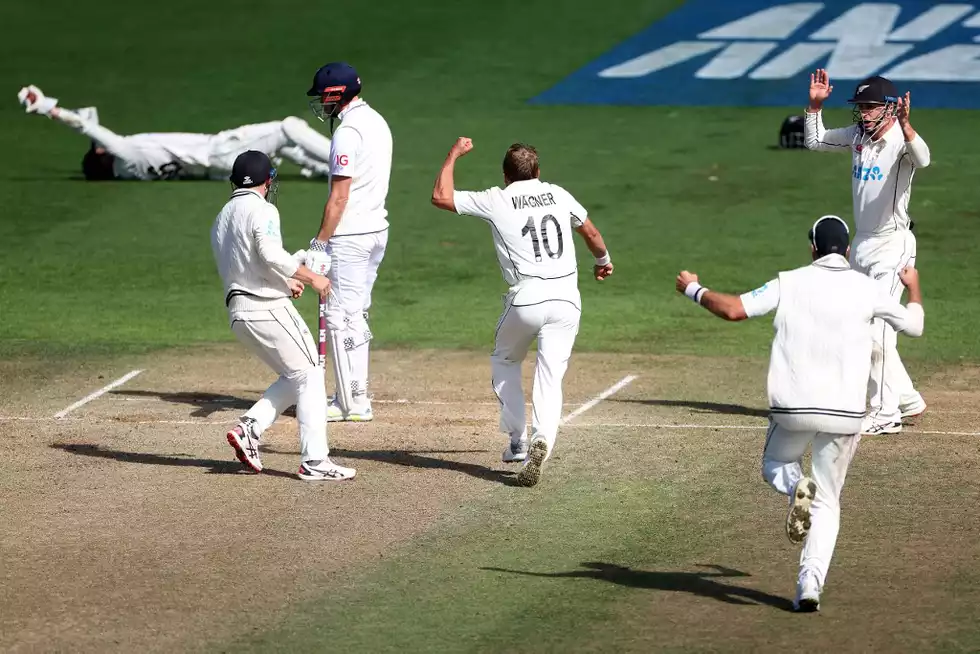New Zealand registered a win by the “barest of margins” in yet another cliff hanger with England in recent times in the second Test in Wellington and squared the series 1-1. Resuming the run chase at 48/1 on the final day, needing 210 runs more to complete a 2-0 win England were bowled out for 256 just before tea. Stats highlights from the historic Test match.
4 Instances of a team winning a Test after being enforced follow on. This is the first such instance not involving Australia who were at the receiving end of all three previous such defeats – against England in Sydney in 1894/95 and in Leeds in 1981, and finally against India in Kolkata in 2000/01.
Winning a Test after following on:
| Winner | Loser | Margin | 1st inngs lead | Venue | Season |
|---|---|---|---|---|---|
| Eng | Aus | 10 runs | 261 | Sydney | 1894/95 |
| Eng | Aus | 18 runs | 227 | Leeds | 1981 |
| Ind | Aus | 171 runs | 274 | Kolkata | 2000/01 |
| NZ | Eng | 1 run | 226 | Wellington | 2022/23 |
1-run win by New Zealand is the second such margin of win across 2494 Test matches. The only other one-run win came in 1992/93 Frank Worrell trophy when West Indies defeated Australia in Adelaide. If the one-run win in Adelaide helped West Indies to extend their unbeaten series run since 1980, the win at Wellington helps New Zealand to clinch to their unbeaten series run at home to 11 series now.
Narrowest win in Tests:
| Winner | Loser | Margin | Target | Venue | Season |
|---|---|---|---|---|---|
| WI | Aus | 1 run | 186 | Adelaide | 1992/93 |
| NZ | Eng | 1 run | 258 | Wellington | 2022/23 |
| Eng | Aus | 2 runs | 282 | Birmingham | 2005 |
| Aus | Eng | 3 runs | 124 | Manchester | 1902 |
| Eng | Aus | 3 runs | 292 | Melbourne | 1982/83 |
| NZ | Pak | 4 runs | 176 | Abu Dhabi | 2018/19 |
3 Test wins for New Zealand by ten runs or a fewer margin, all three such wins coming since 2011. They beat Australia by seven runs in Hobart in 2011/12 and Pakistan by four runs in Abu Dhabi in 2018/19. Kane Williamson – Player of the Match in Wellington – happens to be the only one to feature in all three Tests. This is the fourth instance of England losing a Test by 10 runs or fewer margin with all three previous such losses coming against Australia, the last of which came in 1902.
226 The first innings lead of 226 runs is the highest ever for England that ended in a defeat. The previous biggest lead which ended in an England defeat was 177 against Australia in Manchester in Ashes 1961. It is also the first instance of England losing a Test after taking a first innings lead of 100+ while batting first. The previous biggest first innings deficit overcame by New Zealand to win a Test was 144 against Pakistan in Christchurch in 1993/94.
3.44 England’s run rate in their fourth innings chase – 256 runs scored in 74.2 overs. In 23 innings they batted in Ben Stokes and Brendon McCullum era, only once did they scored at a slower rate – 141 in 42.5 overs against South Africa at Lord’s, a scoring rate of 3.29, which happens to be the only other defeat for England in this period.
302 The partnership of 302 between Joe Root & Harry Brook happens to be the fourth-highest for any wicket that culminated in a Test defeat. Younis Khan and Mohammed Yousuf put together 363 against England in Leeds in 2006 which is the highest ever stand in a loss while the highest for England is 310 by Kevin Pietersen and Paul Collingwood against Australia in Adelaide in 2006/07.
1 Harry Brook became the first batter to score a century and bag a diamond duck in a Test (where balls faced details available). Brook hit his career-best 186 in the first dig and was dismissed run out without facing a ball in the second innings. The only other known instance of an England batter getting dismissed without facing a ball was by Monty Panesar at the Oval in 2008.
248 runs scored by Joe Root (153* & 95) in Wellington is the second-highest aggregate for an England batter in a Test defeat behind Herbert Sutcliffe’s 303 runs (176 & 127) against Australia in Melbourne in 1924/25. Overall, it was just the second of the 29 instances of England losing a Test when Root had scored a century.








